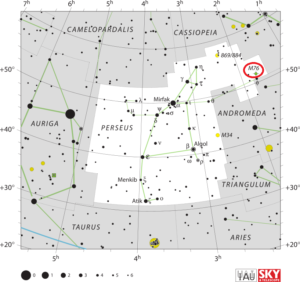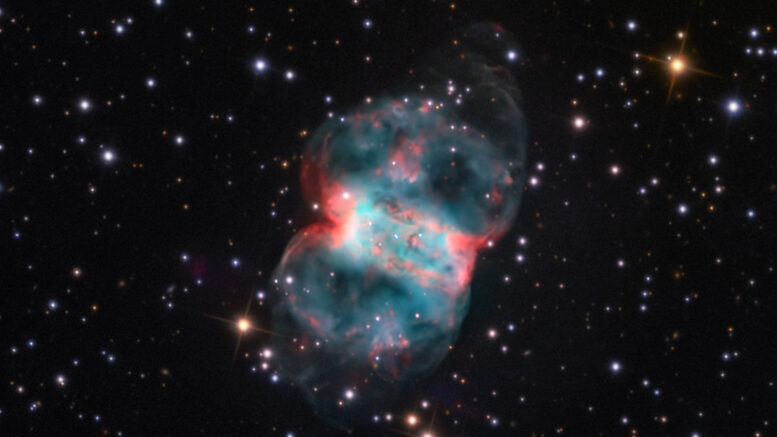Messier 76 is a planetary nebula, which is an expanding shell of gas around an aging or dying star, and it is one of only four planetary nebulas in Charles Messier’s catalog. M76 is located in the constellation Perseus and is approximately 2,500 light-years away from Earth.
| Description | |
| Visible From Pacific Northwest | August To December |
| Best Time To Observe | November and December |
| Minimum Size Of Viewing Device | Binoculars for small light Medium Telescopes For Details |
| Object Type | Planetary Nebula |
| Designations | Messier 76, M76, NGC 650, NGC 651, Little Dumbbell Nebula, Cork Nebula, Barbell Nebula, CSI+51-01391, IRAS F01391+5119, GCRV 950, HD 10346, PN G130.9-10.5, PK 130-10 1, KP98 1, WB 0139+5119, WD 0139+513, PN ARO 2, PN VV 6 |
| Right Ascension | 01h 42.4m |
| Declination | +51°34’31” |
| Constellation | Perseus |
| Apparent magnitude | +10.1 |
| Apparent dimensions | 2′.7 x 1′.8 |
| Object Radius | .617 light years |
| Distance From Earth | 2,500 light years |
History
The Little Dumbbell Nebula was discovered by the French astronomer Pierre Méchain on September 5, 1780. Méchain reported the discovery to his friend and colleague Charles Messier, who subsequently included the nebula in his catalogue of deep sky objects on October 21
William Herschel suspected that M76 was a double nebula, with the two components in contact, and catalogued the second nebula as H I.193 on November 12, 1787. The nebula was later included in the New General Catalogue as NGC 650 and NGC 651, with the latter denoting the eastern portion of M76. Herschel described the object as “two nebulae close together. Both very bright. Distance 2′. One is south preceding and the other north following. One is 76 of the Connoissance.” He would later add that “their nebulosities run into each other.”
Lord Rosse thought the nebula showed evidence of some spiral structure, but was mistaken.
English amateur astronomer and spectroscopy pioneer William Huggins discovered that the nebula’s spectrum was gaseous in 1866. He wrote, “Both parts of this nebula give a gaseous spectrum. The brightest only of the three lines usually present was certainly seen. The second line is probably also present. I suspect a faint continuous spectrum at the preceding edge of No. 386.”
American astronomer Heber Doust Curtis was the first to recognise M76 as a planetary nebula in 1918, even though Welsh amateur astronomer and astrophotographer Isaac Roberts suggested in 1891 that the object may be similar to the Ring Nebula (M57), only seen edge-on. Roberts also discovered that M76 was a single nebula and not a double one.
Locating M76 In The Sky
Messier 76 lies in the eastern part of Perseus constellation, next to the border with Andromeda. It is quite easy to find because it is located just south of Cassiopeia‘s W asterism and about a degree north-northwest of the magnitude 4.0 star Alseiph, Phi Persei. The nebula is in the same region of the sky as the Andromeda Galaxy (M31).

Viewing M76
The nebula’s size and faintness makes it one of the most difficult Messier objects to observe. Large binoculars and small telescopes show M76 as a small, diffuse point of light. The nebula is better seen through medium-sized telescopes. 8-inch telescopes reveal its two lobes and the dark lane separating them, while large instruments show both the double-lobed structure of M76 and the faint halo surrounding it. The best time of year to observe the Little Dumbbell Nebula is during the months of October, November and December.
Photographing M76
Local focal length telescope is suggested for imaging the little Dumbbell Nebula to yield a small imaging scale, this high resolution. Steady seeing conditions, accurate racing and guidance, and sharp focus helps display the detail that this awesome nebula has to offer. Routine TBG imaging and single color cameras can yield god results because the majority of the faint light of the nebula is concentrated into a small area. Luminance layering with a clear filter can help reveal the dimmer components of the nebula. Processing will require as much detail as possible, as sharpening the nebula after making histogram adjustments can reveal more detail. Specific timing will vary depending on setup, so check astrobin and cloudy night for details related to specific setups.
Sources And Further Reading
Descriptions of all of Messier Objects can be found here.
https://www.nasa.gov/feature/goddard/2018/messier-76
https://www.messier.seds.org/m/m076.html

Be the first to comment on "Messier 76 Little Dumbbell Nebula"